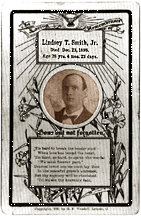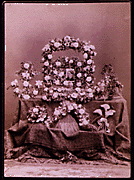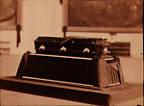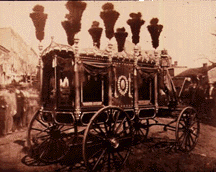THE FUNERAL
A society's funerary ritual--or lack of ritual--is fundamental to its character. The history of funeral practices in America reveals a series of shifts in its collective understanding of the nature of human existence.
The funerals of seventeenth century America were extremely simple. The Puritans, who were more concerned with the condition of the human soul during life rather than after, buried their dead privately, without ceremony. The death was not publicly noted until the religious service of the following Sunday, and was frequently the occasion for a sermon on the wages of sin. Mourning was also a private matter.49
Puritanism lost its hold in the next century. In the rural communities of eighteenth century America, funerals regained the traditional function of reasserting social unity after its disturbance by death. The family affirmed its social connections by the giving of gifts, typically scarves, rings, gloves, or handkerchiefs. The funeral was also an occasion for eating and drinking. A proper funeral was so important that it frequently caused survivors to go into debt.
50
 In the nineteenth century, as the communal life of most Americans became increasingly restricted to the family, the focus of the funeral ritual narrowed as well. Grief, sharpened by the magnitude of loss within so small a sphere, was given a more extreme form of expression. Funerals became increasingly elaborate during the course of the century. Every aspect of the burial process was embellished, with the degree of elaboration limited only by the wealth of the bereaved family. The body was conveyed to the burial site by a hearse, accompanied by appropriately dressed attendants, and given a ceremonial burial. The gravestone, which until mid-century had been a marker carved with simple decorations, became a monument, in some cases a full-scale sculpture.51
In the nineteenth century, as the communal life of most Americans became increasingly restricted to the family, the focus of the funeral ritual narrowed as well. Grief, sharpened by the magnitude of loss within so small a sphere, was given a more extreme form of expression. Funerals became increasingly elaborate during the course of the century. Every aspect of the burial process was embellished, with the degree of elaboration limited only by the wealth of the bereaved family. The body was conveyed to the burial site by a hearse, accompanied by appropriately dressed attendants, and given a ceremonial burial. The gravestone, which until mid-century had been a marker carved with simple decorations, became a monument, in some cases a full-scale sculpture.51
The grieving process began before the actual funeral, and continued long after. Though the tradition of keeping the deceased person in the home for viewing was retained, the body became only one element of an extensive display of symbols of grief. The door of the home was draped in black, as was the room in which the body lay. That room, usually the parlor, was filled with flowers and flower arrangements. The body was ensconced in an ornate coffin, available in a range of materials and as many as a hundred different styles and colors.
52
The funeral traditions which had persisted through the previous century served to diffuse grief within the community. When this possibility no longer existed, the grief of the family was diverted into outward, symbolic expression. The investment in funerary accoutrements, both financial and emotional, was considerable.
Photography was to become yet another accoutrement. From the 1860s onward, photographers were more and more frequently documenting flower arrangements in addition to, or even instead of, the postmortem pictures of the previous few decades. The funeral flowers might be photographed in the home, with or without the body of the dead person. In other instances, they were brought to the photographer's studio and arranged in tableaux created strictly for the camera. In many of these, photographs of the deceased, made while alive, act as surrogates for the body.
Though flowers had a centuries-old association with death that had probably originated in the concept of paradise as a garden, their association with funerals was a phenomenon of the nineteenth century.53
Their transitory beauty, a poignant symbol of mortality, gave them special charm in an atmosphere of overtly expressed sentiment. They could also be fashioned into arrangements that compounded their symbolic implications. These arrangements were available in a wide variety of designs, some of which made specific reference to the deceased person. A closed book, for instance, was used only for adults, as it represented the closing of the book of life. A broken column was often used to symbolize an early death, as was a broken circle, whereas a sheaf of wheat, emblematic of harvesting, was used exclusively for the aged. Other arrangements had more general meanings. A pillow signified death as sleep. Crosses, anchors, and hearts, representing faith, hope, and charity, could be used separately or together.54

The photographer commissioned to photograph these flower arrangements--as well as the florist who made them--had become part of a funerary industry that did not exist in the beginning of the nineteenth century, but which had attained most of its present-day features by the end. The family, with help from community members, had traditionally clothed and prepared the body for burial, and accommodated visitors. The family also arranged for the construction of a coffin and its transportation, the burial, and the creation and erection of a gravestone. In the rural communities and small cities of the eighteenth century, assistance was near at hand. In the rapidly-emerging urban environment of the nineteenth century, this was no longer the case, and the undertaker gradually assumed (literally undertook) all of the functions connected with the funeral and burial.55
In addition to the customary tasks associated with the funeral and burial, the undertaker also assumed the entirely new functions of embalming the body and of applying cosmetics to restore the appearance of life. The practice of embalming in America initially had the utilitarian purpose of preserving the bodies of Civil War soldiers for shipment to their homes.56
It received widespread public attention immediately after the war, due to its employment in preserving the body of Abraham Lincoln for viewing in a series of funerals that extended over twelve days, in twelve cities. A matter-of-fact description of the success of the procedure can be found in a report from a Chicago newspaper on the viewing of Lincoln's body in that city, eighteen days after his death in Washington:
The President was neatly dressed in a suit of black. His face was somewhat discolored, but not more than we remember to have seen in cases of gunshot wounds. Otherwise his countenance exhibited an extremely natural and life-like appearance, more as if calmly slumbering, than in the cold embrace of death. It did not require a vivid imagination to discover a placid smile resting upon that marble face.57
Embalming was a necessity only in cases in which a person died somewhere other than the place of burial. Its utilization as part of the routine undertaking procedure was not at all necessary. As a means of extending the period of viewing, embalming was nevertheless desirable, and was in fact merely the first step in a process continued by the application of cosmetics, and prolonged by the photographer, who recorded the results.
In the sociological and psychiatric literature on the subject of funerals, the viewing of the body of the deceased person is almost universally acknowledged as useful in the recognition of the fact of death, and as a healthy aspect of the adjustment required of the survivors.58
The embalming and cosmeticizing of the corpse, on the other hand, perpetuates the image of life, making the body a symbol of continuity rather than finality. The necessity of reconciling these contradictory mental images has also been acknowledged:
The great problem for survivors in all cultures is to convert "homeless souls," particularly those of the recently dead, into comfortably enshrined or immortalized souls. Funeral ceremonies are rites of passage precisely for this purpose. What is involved is the symbolic transformation of a threatening, inert image (of the corpse) into a vital image of eternal continuity (the soul)--or of death as absolute severance to death as an aspect of continuous life.
59
(Emphasis in original.)
In the circumstances of acute grief that existed in the nineteenth century, this reconciliation is postponed, sometimes indefinitely. Survivors are not able to separate their mental image of the deceased person from the physical being of that person. The efforts of the survivors are devoted to the retention of this image instead of its release.
In addition to the symbols of grieving already discussed, the investment in this image took outward form in the physical appearance of the mourners. Mourning, which extended for a much longer period than had previously been the custom, was publicly demonstrated by the adoption of mourning costume, which varied in its severity according to the length of time of the bereavement. The initial period of mourning lasted a full year, during which bereaved women dressed entirely in black, and men wore black clothes with white linen. During the first six months, the period of deepest mourning, men and women were expected to withdraw from society as much as possible. Though men could conduct business, they were expected to curtail their social lives. During the second year, as social contact increased, the amount of black prescribed for both men and women decreased until, at the end of this period, normal clothing and social relations could be resumed.60
The open display of mourning intensified when the deceased person was an honored public figure. It reached its apogee with the death of Abraham Lincoln, the first President to be assassinated. Twenty-five million people--a significant majority of the population--are estimated to have participated in memorial services, attended viewings of the body, or watched the passing of the funeral train on its route from Washington, D.C. through Maryland, Pennsylvania, New York, Ohio, Indiana, and Illinois, to the burial site in Springfield.
61
The unprecedented magnitude of the response to Lincoln's death was not to be duplicated until the assassination and funeral of John F. Kennedy nearly a hundred years later.
Otto Rank, an early follower of Freud's, paid particular attention to the relationship of a group to its leader. He also differed from Freud in theorizing that the most basic human anxiety is a fear of death. According to Rank, individuals seek to immortalize themselves by a denial of death, while groups seek to do the same by submission to a leader invested with larger-than-human powers.62

Inasmuch as a leader represents the perpetuation of a society, the death of that leader restores the fear that it will not be perpetuated, and leaves a void that cannot simply be filled by the installation of another. This is especially true if the deceased leader, like Lincoln, had been charismatic, and had successfully taken the group through a severe crisis. The violence of Lincoln's death undoubtedly contributed to the extremity of the public reaction as well, but it was not a primary factor. When James A. Garfield--a far more ordinary man, and President in a much less fateful time--was assassinated fifteen years later, the public response was lukewarm by comparison. If Lincoln's death was an irrevocable loss, his funeral was, in one ironic respect, a gain. The extremity of emotion it brought forth was a necessary catharsis. It restored a sense of community that had been dissipated by the changing circumstances of the era, and further fragmented by the disruption of the Civil War. In doing this, it also renewed a function of the funeral that had been disappearing--the assertion and restoration of commonality.

Next
Memento Mori: Death and Photography in 19th Century America by Dan Meinwald
 In the nineteenth century, as the communal life of most Americans became increasingly restricted to the family, the focus of the funeral ritual narrowed as well. Grief, sharpened by the magnitude of loss within so small a sphere, was given a more extreme form of expression. Funerals became increasingly elaborate during the course of the century. Every aspect of the burial process was embellished, with the degree of elaboration limited only by the wealth of the bereaved family. The body was conveyed to the burial site by a hearse, accompanied by appropriately dressed attendants, and given a ceremonial burial. The gravestone, which until mid-century had been a marker carved with simple decorations, became a monument, in some cases a full-scale sculpture.51
In the nineteenth century, as the communal life of most Americans became increasingly restricted to the family, the focus of the funeral ritual narrowed as well. Grief, sharpened by the magnitude of loss within so small a sphere, was given a more extreme form of expression. Funerals became increasingly elaborate during the course of the century. Every aspect of the burial process was embellished, with the degree of elaboration limited only by the wealth of the bereaved family. The body was conveyed to the burial site by a hearse, accompanied by appropriately dressed attendants, and given a ceremonial burial. The gravestone, which until mid-century had been a marker carved with simple decorations, became a monument, in some cases a full-scale sculpture.51


